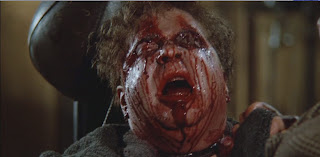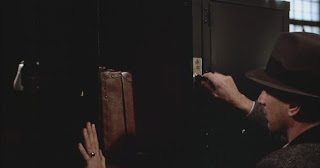Directed by: Sergio Leone
Filmed in:
Released in
Genre: Gangster Thriller
Produced by: Warner Bros. Pictures
Official Trailer - Once Upon A Time in
#
This film was set in 1933 on the 5th of December; the day prohibition ended in the USA
Gangster and mobs were also involved with organised crime, which police found hard to control; these included, Drug trafficking, Human trafficking, Sex trafficking, Illegal immigration, and contemporary slavery and unfree labour.
In the opening of the film, towards the end of the credits, and throughout the beginning of the opening scene, we are made aware of the non-diegetic sound of the song ‘God Bless America’ being played on the radio; this song in itself can be related to ‘The Deer Hunter (1978)’ when the family are around the table and sing the song. 'The Deer Hunter' is made by an Italian director Michael Cimeno. The song 'God Bless America vietnam
The movie is set in a corrupt nation, and this implies that Sergio Leone is showing irony through the song, by suggesting that the wonderful nation of America America America
The first signifier that Sergio Leone has used is the diegetic sound of footsteps; this is a generic signifier and is used in many thriller films, for example Kill Bill Vol 1, when bill is heading towards the room. It is a way or creating tension, and building the suspense within the film. When Eve opens the door, the noir lighting has been used to create shadow and to create a mysterious effect. This establishes the genre immediately. It then shows a noir silhouette of Eve at the entrance of the door, this is a generic signifier. In the shot above, it shows half of Eve’s face in the light, and half in the shadow, this could imply that she may not be as innocent as we may have assumed. Her face in the shadows can be related to that one of Jason in Essex boys, when we are first introduced to him through the windscreen, half of his face is in the shadow, which signified that he had ominous qualities. The film perceives her to be an archetypal character- a femme fatale; this is another thriller convention that has been used in this opening scene. It indicates that she is a dangerous woman, or a woman involved with dangerous men, or business. From Eve’s appearance, her glamour is evident. She is wearing red nail polish, and rings on her fingers which suggest danger. She is also carrying pearls around her neck; pearls represent tears, they were classed as an unlucky superstition, this may be Sergio Leone’s way of foreshadowing the following events. The name ‘Eve’ also refers to evening time, which is the generic time in most thrillers, for crimes and violence to occur. In the film, she is a gangster’s mistress, which means that she is definitely not an innocent woman; she has been engulfed into a life of danger and threat; for wealth and noodles.
This shot shows that Eve is the same colour of the light, and that she is as beautiful as the light. This image also displays her elegance, beauty and style; her pearls are glowing, which may indicate that she is a vulnerable character. The non-ambient light from the lamp makes the shot look sepia, and matches with the colours of her clothes, this refers back to style, and it may also be implying that she possesses warmth. Because it is lighting her face, it gives less mystery to the character and also reveals her innocence and purity to the audience
.
Their costumes can be referred to 'reservoir dogs' (1992) directed by Quentin Tarantino. The group of men that stand in this shot can also be linked to the group of men in that film also. In both films, the group of men act like a pack, it is a feature that Tarantino and Leone have used to symbolise which are the main characters, by putting them in almsot identical suits, this shows they are all important and that they work together.
Sergio Leone has used this particular shot to create tension and suspense; he has used three men instead of one; three men, is much more intimidating and dangerous than one. Their costumes reveal clearly that they are from the 30’s, they are all dressed very similarly, this makes the audience wonder they are connected by a gang or club. The three men also share the serious expressions on their faces. The character in the centre of the image is displaying a gun, the one to the far right of the picture is slightly out of focus, and the other two in focus- this draws the eyes of the audience to the centre character, who bears a weapon, and is an important character within this scene as he is the killer.
Leone has used a specific camera shot and angle, which are often used in thrillers. It shows Eve in the foreground and therefore the audience focus on the barbarity of her death. This is a powerful shot that shocks the audience as we can see Eve’s face staring blankly into the audience and that she is dead. The arch way in the shot works as a frame, to draw the audience to the corrupt cops that are slightly out of focus. The out of focus shots, is Sergio Leone’s way of displaying criticism towards the law in the USA during the 1930’s, it also communicates to the audience the power the three men withhold as they stand in a three, framed by the archway. The lamp to the left of the screen contrasts with Eve now. She is now not, beautiful and bright, she is lifeless. This is shown when the light is turned off by one of the male characters
This shot is shown straight after the scene of Eve’s death, this makes the audience believe that there is a second murder about to occur. A close up of the man’s swollen face covered in blood, reinforced the brutality and cruelty that occurred during this time period. This scene also uses Match on action between the police man, and the bleeding character.
Sergio Leone has used this generic worms eye shot of the lift shaft and a lift coming down,after the scene of Eve’s death and the mans bloody face, helps to build tension and suspense as the a lift is a generic location for a thriller due to the encolsed space and sense of isolation. It entails the sense of chlaustrophobia and entrapement along with danger. He has used this shot to enforce the reality that the lift could fall on him, and the entrapment the character may feel as the shot makes it look as if the character is in a room who’s ceiling is coming down. This shot is also used to make the lift look mighty and make the audience feel small. The non-ambient lighting used, makes the shot look dark and dangerous, just like the storyline of this film.
This generic worms eye shot has been used by Sergio Leone, to create tension and fear. The shot shows the character upside down as this is how the audience would see him, it creates confusion amogst them, to show how the character would feel. It also shows the power and sheer importance that the character above him holds within the film. The use of violence and death within the opening scene is establishing the thriller genre, it communicates to the audience the corruption within the society in the 1930’s, this also links back to the song at the beginning of the film, and the irony of ‘God Bless America’ within this film, of crime, corruption and death.
In the previous scene, Sergio Leone, has made Noodles- the main character to be a heroic man, but in reality he could almost be classed an antihero because he is shown smoking opium in this scene, a flaw in the heroic perception, as well as the fact he is not married to Eve although he lives with her. Noodles is a gangster, and within this scene he has a flash-back, Leone has used the loud ringing of a telephone as a sound bridge in order to create tension and make the audience impatient and agitated by the repetitive sound.
Leone has used chiaroscuro lighting to show the three dead bodies of Noodle’s friends on the floor, laying under the rain. This shot is generic to the thriller genre as it contains dead bodies- something of which is used commonly in thrillers. The lighting used relates to nightmares, and reality. The noise of the telephone is on-going, and this creates a tense atmosphere amongst the audience.
The briefcase and the locker in this shot are also generic conventions used within the film, as the locker can signify secrecy and claustrophobia; it is a very confined space. The briefcase however is a generic convention but is enigmatic as the audience are unaware of the contents, this can be referred to Kill Bill Vol 1 when Bill also has a briefcase which is enigmatic and the contents kept secret. Pulp Fiction is another film that can be intertextually referenced to this section of the film, In pulp fiction the contents of the briefcase is also not revealed, thus making it enigmatic.










My teacher commented:
ReplyDeletevmbJan 9, 2012 05:15 AM
You say in your first sentence...and was released the night prohibition ended in 1984...! Whoops, please revise, the opening sequence of the film is 5 December 1933 the day Prohibition ended in the USA.
If you were to watch the film the narrative structure is very complicated, whereas The Deer Hunter has a linear narrative, whilst Leone's film moves backwards and forwards from the 1930's to the 1900's and to the 1980's rather like memory.
You reference "The Deer Hunter" (1978) also made by an Italian director Michael Cimeno. In this film the track "God Bless America" is played in the final sequence and is used ironically against a backdrop of war damaged Vietnam veterens at a funeral tea. Sergio Leone in a sense pays homage to Cimeno by opening his film with the same song Cimeno signed his film off with, thus Leone is connoting that his film will also have a similar grand narrative and focus on a gang/group of male friends who are engulfed in a kind of Darwinian gangster war involving betrayal, treachery and corruption, one could say much like the Vietnam War.
Your intertextual reference to "Reservoir Dogs" you say ....Their costumes can be referred to reservoir dogs, and the group that they stand in can also be linked to the group of men in that film also.. Be more specific, the similarity of costume and the sense of group/pack identity is a feature explicitly used by Tarantino in "Reservoir Dogs" with the main characters wearing almost identical suits.
Re the suitcase, also in Pulp Fiction the contents of the brief case are not revealed.
With some advised revisions this could be a strong Level 4. A splendidly detailed and perceptive analysis of the way Leone utilises intertextuality and generic conventions in Once Upon a Time in America. Note in the scene with Noodle's 3 dead friends laid out in body bags, the persistent sound of rain juxtaposed with the sound bridge of the telephone ringing, the noir lighting, wet streets are splendid examples of a classic thriller at its best.
With revisions this case study is a strong Level 4, at the highest level of conceptual understanding.
ReplyDelete